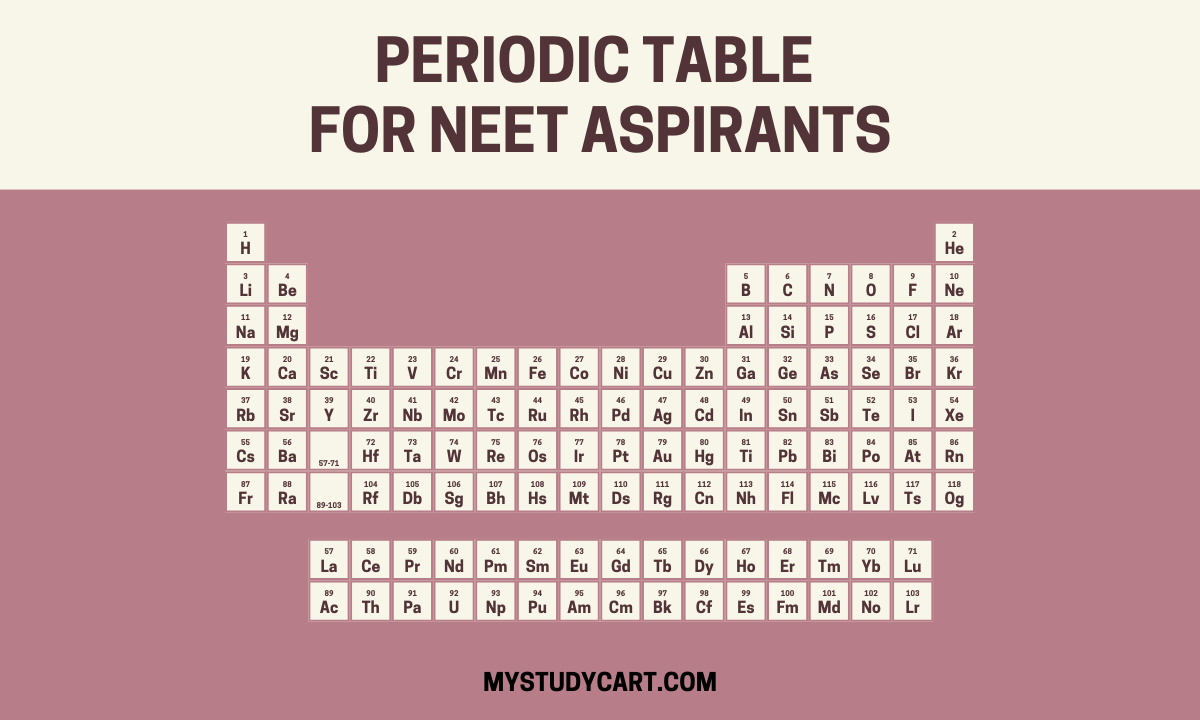Is the Periodic Table Important for NEET?
Absolutely! The periodic table is the cornerstone of chemistry, and its significance in NEET cannot be overstated. It provides a structured framework to understand the behavior of elements, their properties, and their interactions. A solid grasp of the periodic table is essential for tackling questions in NEET inorganic, physical, and organic chemistry.
Periodic Table for NEET Aspirants
For NEET aspirants, focusing on the following aspects of the periodic table is crucial:
- Elemental symbols and atomic numbers: These are the basics and must be memorized.
- Periodic trends: Understand the trends in atomic radius, ionization energy, electron affinity, electronegativity, and metallic character. These trends will help you predict the behavior of elements without memorizing individual values.
- Groups and periods: Familiarize yourself with the names and characteristics of different groups and periods.
- Block classification: Understand the p, d, and f blocks and the electronic configurations of elements in these blocks.
- Important elements and their compounds: Focus on elements and compounds frequently mentioned in NEET syllabus.
How to Memorize the Periodic Table for NEET
While rote memorization might work for some, it’s often inefficient and unsustainable. Here are some effective strategies to memorize the periodic table for NEET:
- Visual aids: Create colorful charts, flashcards, or mind maps to visually represent the periodic table and its trends.
- Mnemonic devices: Develop creative ways to remember the order of elements, such as using mnemonics, acronyms or rhymes.
- Periodic table songs: There are many catchy songs available online that can help you memorize elements and their properties.
- Practice questions: Regularly solve problems based on the periodic table to reinforce your learning.
- Group study: Discuss and quiz each other with periodic table-related questions.
- Online resources: Utilize interactive periodic tables and online quizzes to enhance your learning experience.
Is It Necessary to Memorize the Periodic Table for NEET?
Yes, but not blindly. Remember, understanding the concepts behind the periodic table is more important than simply memorizing it. By combining memorization techniques with a solid conceptual foundation, you can effectively master the periodic table for NEET.
How Many Elements to Learn for NEET?
You don’t need to learn all 118 elements in the periodic table for NEET. Focus on the elements that are frequently tested and relevant to the NEET syllabus.
Key Areas to Focus On:
- S-block elements: Alkali and alkaline earth metals. [Removed from NEET-UG Syllabus]
- P-block elements: Understand the general trends and properties of groups 13 to 18. Pay special attention to elements like nitrogen, oxygen, phosphorus, sulfur, chlorine, and their compounds.
- D-block elements: Focus on the general properties and electronic configurations of transition metals.
- Representative elements: These are the elements in the s and p blocks. Understand their periodic trends and chemical properties.
Periodic Table NEET Questions
NEET questions on the periodic table often revolve around understanding periodic trends, properties of elements and their compounds, and their applications.
Common Types of Questions:
Periodic Trends:
- Comparison of atomic radius, ionization energy, electron affinity, electronegativity across periods and groups.
- Identification of elements based on given trends.
- Explaining chemical reactivity based on periodic trends.
Chemical Bonding:
- Formation of ionic and covalent bonds based on electronegativity differences.
- Lattice energy and its relation to ionic bond strength.
Properties of Elements and Compounds:
- Physical and chemical properties of alkali metals, alkaline earth metals, halogens, and noble gases.
- Acidic and basic nature of oxides and hydroxides.
- Allotropy and its examples.
Metallurgy:
- Extraction of metals based on their positions in the periodic table.
- Properties of metals and their alloys.
Coordination Compounds:
- Ligands and their coordination number.
- Color and magnetic properties of coordination compounds.
Example Questions on Periodic Table NEET
1. Which of the following elements has the highest electron affinity?
A) Fluorine
B) Chlorine
C) Bromine
D) Iodine
2. The element with the largest atomic radius in Period 3 is:
A) Sodium
B) Magnesium
C) Aluminium
D) Chlorine
3. Which of the following is a noble gas?
A) Oxygen
B) Argon
C) Chlorine
D) Sodium
4. The metallic character of elements generally:
A) Increases across a period
B) Decreases across a period
C) Remains constant across a period
D) Increases down a group
5. Which of the following is the correct order of increasing ionization energy?
A) Li < Be < B < C
B) C < B < Be < Li
C) B < Be < Li < C
D) Be < Li < B < C
6. The element with the highest electronegativity is:
A) Fluorine
B) Oxygen
C) Nitrogen
D) Chlorine
7. Which of the following is a characteristic of alkali metals?
A) High ionization energy
B) Low electronegativity
C) High electron affinity
D) Formation of colored compounds
8. The group which contains the most reactive non-metals is:
A) Alkali metals
B) Halogens
C) Noble gases
D) Alkaline earth metals
9. Which of the following elements forms an amphoteric oxide?
A) Sodium
B) Magnesium
C) Aluminium
D) Chlorine
10. The period to which the element with atomic number 19 belongs is:
A) 2
B) 3
C) 4
D) 5
Related Pages :
How Can One Memorize a Lot of Stuff to Crack NEET?
Tips to Memorize Biology for NEET Faster and Easier
Tips and Tricks to Remember Complex Things (Examples, Tables) for NEET


